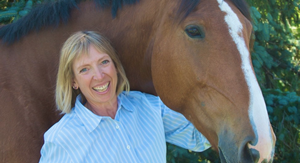Do you have trouble riding clean transitions? Brace against the horse’s back? Stiffen in your hips, knees or ankles? A mini-trampoline is a great way to get your transitions flowing.

Next time you ride notice what happens when you ride a series of transitions. Is the horse abrupt, resistant or delayed in responding? Do you stop before he does or pitch forward for upward transitions? Do you hope for a good halt?
For good transitions you have to keep riding until the horse responds. You have to keep your joints moving, especially the hips, knees and ankles. This allows you say in balance and absorb the horse’s movement rather than block him.
Look in your garage, basement or check some yards sales on the weekend. You will probably find a mini-trampoline hidden away somewhere or you can purchase one for around $50.00. A mini-tramp offers suspension and give – qualities we want to feel when riding transitions. It is a wonderful feedback mechanism giving you insight into how what you do as a rider affects your horse. And, unlike the horse, the mini-tramp never gets tired or grumpy, never needs to be fed or have it’s stall mucked out and will live happily in a corner of your room or under the bed.

If you have never been on a mini-tramp before make sure you have a “spotter”, someone who can help if you get off balance. Working with a friend is a good idea even if you are familiar with the mini-tramp. Place it is on a level non-slip surface away from any sharp objects or furniture. Start slowly at first.
Begin by gently bouncing with both feet in contact with the trampoline at all times. Are you feet far apart or close together? Experiment with different widths until you find the place where the tramp gives you the most spring. The wider your base the more stable you are but this reduces the upward movement. If your feet are too close together you will be unstable.
Keep your heels on the tramp and find out how high can you bounce using the least amount of effort. This is not a big movement. You want to feel the direction of the tramp. Are you going more up than down or down that up? To find the up you have to allow the trampoline to send you up (receiving the motion) and then follow it back down. If you try to “drive” the trampoline (pushing downward on your feet) or bounce too fast (not in the tramps natural rhythm) you will decrease the upward oscillation. Riding the downbeat will drive your horse into the ground while riding the upbeat allows him to come up under you.

Experiment with stiffening different body parts while making this little bounce. Tighten your jaw, fingers, toes, lower back and hold your breath. What happens to the direction of the tramp, the overall movement and your balance? Any stiffness in your body limits the upbeat and increases the downbeat. This makes you heavy and will ultimately destroy the natural springiness of the trampoline and your horse.
When you think you have found the upbeat, go slower. Let your joints be stretchy as you keep the up. Allow the trampoline do most of the work for while you look for any areas of stiffness within your body. Notice that the up goes all the way through to the top of your head just like the thoroughness you are looking for in your horse.
Pick up a trot by jogging in place. Are you pushing the tramp down again or can you find the up feeling? Look for areas of stiffness. Allow your arms to hang freely. Trot slowly – it will improve your ability to receive the upward spring of the tramp.
Check out transitions from trot to walk or halt, then back to trot again. You and the trampoline should make the transition together without any aftershocks. If you brace against the tramp in the halt you will be bounce after your feet have stopped moving. Notice if you stiffened your knees or stood up. Repeat the transition keeping your knees soft and slightly bent. The two of you (trampoline and rider or horse and rider) should begin and end each movement together.
Use this Murdoch Minute to practice your trot/halt transitions on the trampoline. You will develop greater fitness while improving your timing and balance in the comfort of your living room. Happy tramping and always remember to enjoy the ride!
Wendy Murdoch is available for lessons and clinics in the Northern Virginia region as well as throughout the United States. She teaches riders of all levels and disciplines how to improve the horse’s performance by improving their body position. On-line join Wendy’s Facebook group Fans of the Murdoch Method and find more articles, blog and her new book 50 5-Minute Fixes to Improve Your Riding, based on the Murdoch Minutes at www.murdochmethod.com




